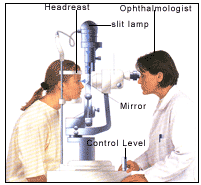|
|
Pterygium or Callus on the Eye
 A pterygium is a growth of scar tissue and blood vessels on the sun-exposed
surface of the eye in response to ultraviolet damage from the environment. A
pterygium often grows in a "wing" shape,, which extends across the cornea towards
the pupil. It most often occurs on the inner side of the pupil. Before growing
across the cornea there is a scaly red thickening of the conjunctiva known as a
pingueculum. Whilst the rednes can be aggravated by wind and other external
irritants it is the lack of adequate protection from sunglasses that causes the
permanent growth onto the cornea A pterygium is a growth of scar tissue and blood vessels on the sun-exposed
surface of the eye in response to ultraviolet damage from the environment. A
pterygium often grows in a "wing" shape,, which extends across the cornea towards
the pupil. It most often occurs on the inner side of the pupil. Before growing
across the cornea there is a scaly red thickening of the conjunctiva known as a
pingueculum. Whilst the rednes can be aggravated by wind and other external
irritants it is the lack of adequate protection from sunglasses that causes the
permanent growth onto the cornea
One or both eyes may be involved. The cause is unknown, but it is more frequent
in people with excess outdoor exposure to sunlight and wind, such as those who
work outdoors.
Causes
The cause or causes of these disorders are unknown, but they are more frequent
in people who live in sunny and windy climates and people whose jobs expose them
to ultraviolet (UV) light (for example, farmers and arc welders). It is thought
these growths are the result of UV or infrared light and irritation. It is also
believed that prolonged exposure to these risk factors (that is, UV light)
increases the chances of occurrence. Risk factors are exposure to sunny, dusty,
sandy, or windblown areas.
Symptoms:
 The primary symptom of a pterygium is a painless area of elevated white tissue
with blood vessels on the inner and/or outer edge of the cornea. Some feel like
they have a foreign body in their eye. Because a pterygium can stretch and
distort the cornea, some people acquire astigmatism from a pterygium. The primary symptom of a pterygium is a painless area of elevated white tissue
with blood vessels on the inner and/or outer edge of the cornea. Some feel like
they have a foreign body in their eye. Because a pterygium can stretch and
distort the cornea, some people acquire astigmatism from a pterygium.

Diagnosis
An eye doctor (ophthalmologist or optometrist) can usually diagnose pterygia by
external observation, generally using an instrument called a slit lamp. A slit
lamp is a microscope with a light source and magnifies the structures of the eye
for the examiner.
Treatment
Usually, no treatment is needed. Artificial tears can be used to relieve the
sensation of a foreign body in the eye and to protect against dryness. Surgery
to remove the pterygium is advisable when the effect on the cornea causes visual
defects or when the thickening is causing excessive and
 recurrent discomfort or
inflammation. Sometimes surgical removal is also performed for cosmetic reasons.
However, healing from this type of surgery, although usually painless, takes
many weeks, and there is a high rate of recurrence (as high as 50-60% in some
regions). Accordingly, surgery is avoided unless problems due to the pterygium
are significant. recurrent discomfort or
inflammation. Sometimes surgical removal is also performed for cosmetic reasons.
However, healing from this type of surgery, although usually painless, takes
many weeks, and there is a high rate of recurrence (as high as 50-60% in some
regions). Accordingly, surgery is avoided unless problems due to the pterygium
are significant.
Several methods have been used to attempt to reduce the recurrence of pterygium
after surgery. One method that should be abandoned is beta radiation. Although
it is effective at slowing the regrowth of pterygia, it can cause cataracts. A
preferable method is the topical application of the anticancer drug, mitomycin-C.
The complications include regrowth, ulceration within the operated area, and
infections. A change in vision is likely only if the pterygium extends close to
the pupil. The complications can almost always be avoided if the eye is
protected from irritants and kept well lubricated for six weeks after surgery.
For this reason the operation should not be contemplated unless you are prepared
to make the lifestyle sacrifices required to ensure a good result is obtained.
No amount of surgical expertise can give a good result if the eye is exposed to
irritants during the healing period.
Prevention
-
 Wearing wrap around sunglasses when exposed to sun and wind will prevent a
pterygium as well as skin cancer of the eyelid, and may delay the onset of
cataract and age related macular degeneration. The American Optometric
Association (AOA) suggests that sunglasses should block 99-100% of UV-A and UV-B
rays. Wearing wrap around sunglasses when exposed to sun and wind will prevent a
pterygium as well as skin cancer of the eyelid, and may delay the onset of
cataract and age related macular degeneration. The American Optometric
Association (AOA) suggests that sunglasses should block 99-100% of UV-A and UV-B
rays.
-
If the eyes are reddened from a day outdoors the appropriate action is to use
artificial tears frequently and decongestant drops infrequently. Artificial
tears help the eye to recover provided they do not contain strong preservatives
Related Links
|
|
|
|
|









